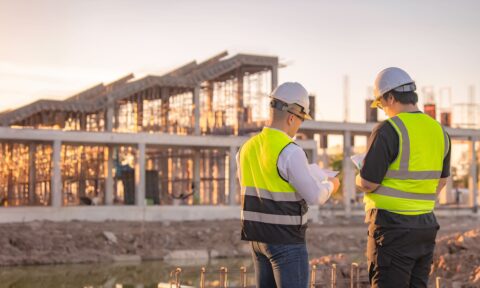Design of Lightweight Engineering Structures; Composite & Aluminium
- Design of Lightweight Engineering Structures; Composite & Aluminium.
- Materials with high strength-weight ratio are crucial in structural engineering and transport.
- Lightweight members reduce stress levels and handling costs in constructions.
- Alloys of aluminium and fibre-reinforced plastics are commonly used in lightweight applications.
- Course covers composite materials, analysis, design, and application in various industries.
- Lecturers have extensive experience in marine structures, wind energy, and composite materials.
Overview
The course on Design of Lightweight Engineering Structures focuses on the application of materials with high strength-weight ratios in structural engineering and transport. It emphasizes cost savings through the use of strong but lightweight members, reducing stress levels and handling costs. The course covers topics such as composite materials, aluminium structures, and their design considerations for various applications in industrial structures. Expert lecturers provide insights into composite materials selection, analysis, and design, as well as the behavior and performance of aluminium structures in different loading conditions.
Who should attend
Engineers, Structural Engineers, Designers
Course Content
ABOUT THE COURSE
The main application for materials possessing high strength-weight ratio are in structural engineering, transport and portable appliances. Cost savings is one of the criteria for successful structural engineering and transport application. The use of strong but lightweight members helps to achieve this in that the overall stress levels in a construction are reduced together with handling, manipulation and pay-load cost. These factors are important in such applications as bridges, ships, high speed vessels, rail and transport carriers.
As light-weight applications mean the use of strong but low-density materials, alloys of aluminium are generally used. However, new approaches in fabrication techniques are leading to high use of
fibre-reinforced plastics.
COURSE OUTLINE
Day 1
9:00—10:30
Lecture 1: Introduction to Composite Materials
By Dr Narasimhan Sampathkumar
Introduction: Products & Structures – Basic Definitions and Classifications – Constituent materials and types of composites – Reinforcements and Fillers
10:30 – 10:45 Break
10:45—12:15
Lecture 2: Fundamentals of Composite Structures
By Dr Narasimhan Sampathkumar
Mechanics of Composite Structures – Linear elastic Stress-Strain
characteristics of FRP Composites – Stress-Strain concepts in 3D
– Anisotropic Elasticity – Plane stress 2D elasticity concept –
Theory of Laminates
12:15 – 13:30 – Break
13:30—15:00
Lecture 3: Selection of Composite Materials
By Dr Narasimhan Sampathkumar
Selection criteria for Composite Materials Advantages and limitations of Composites – Comparison among the types of Composite
materials and its applications – Manufacturing process of various
Composite Structures – Testing methods – Codes & Guidelines
for Design/Applications
15:00 -15:30 Break
15:30—17:00
Lecture 4: Analysis & Design of Composite Structures
By Dr Narasimhan Sampathkumar
Analysis by Finite Element methods for Composite material components – Material non-linearity in Composites – Failure mechanics in Composite Structures – FEA Software programs
Design considerations: Material, Product and Manufacturing –
Design of Material structure – Design for Function –
Design of adhesively bonded joints – Design of Sandwich Structures
Day 2
9:00—10:30
Lecture 5: Introduction to Aluminium Structures
By Prof Purnendu Das
Introduction to material properties of aluminium. Applications in
various aspects. Different types of structural components such as
stiffened plates, beam columns
10:30 – 10:45 Break
10:45—12:15
Lecture 6: Design for Buckling & Strength for
Aluminium Structures
By Prof Purnendu Das
Behaviour and performance of aluminium structures in different
loading conditions.
15:00 -15:30 Break
13:30—15:00
Lecture 7: Application of Composites in
Industrial Structures – I
By Dr Narasimhan Sampathkumar
Applications in Transportation systems, Civil Engineering Structures, Industrial, Aerospace and Health diagnostics
15:30—17:00
Lecture 8: Application of Composites in Industrial
Structures – II
By Dr Narasimhan Sampathkumar
Applications in Offshore Oil and Gas, Sub-sea structural components, Onshore/Offshore Wind turbine components and in Defence
ABOUT THE LECTURERS
Prof Purnendu Das.
BE, ME, PhD, C.Eng, C.MarEng, FRINA, FIStructE, FIMarEST has been the Director of ‘ASRANet Ltd’ (an ISO 9001-2008 certified company) since February 2006. He retired as a Professor of Marine Structures in the Department of Naval Architecture & Marine Engineering at the University of Strathclyde, UK in September 2011. Past EU projects were MARSTRUCT (a network of excellence on Marine Structure) and SHIPDISMANTL (a cost effective
and environmentally friendly dismantling of ship structures). Past industrial projects included work from the UK Health and Safety Executive (HSE),
MoD UK, Subsea-7 UK, Shell, Woodgroup and US Navies etc. He was the principal investigator of many EPSRC projects. Before joining the University
of Glasgow in 1991 he worked with British Maritime Technology as Principal Structural Engineer (1984-91). He is the author of more than 250 publications, including contract reports and more than 60 journal papers and is a member of the editorial boards of the ‘Journal of Marine Structures’,
‘Journal of Ocean and Ship Technology’ and ‘Journal of Ocean and Climate System’ and the Journal of Ship Mechanics amongst others. His areas of
research include limit state design and analysis & reliability analysis of ship & offshore structures. Purnendu Das has wide ranging industrial and
academic contacts and has advised and supervised 20 PhD students, to his credit. Details of visits and collaborations include his various sabbatical
study periods spent at University of California, Berkeley, USA (July – September 1996), at Lloyd’s Register of Shipping (August 1997), Kockums Ltd
(July 1998) and spent some time at Instituto Superior Técnico (IST), Lisbon (July 2000). He is running about 20 CPD courses which are attracting
many people from different industries. These courses are on ‘Fatigue & Fracture Analysis’, ‘Ships at Sea’, ‘Advanced Analysis and Design of Offshore
Structures’, ‘Offshore Floating System Design’, ‘Structural Response under Fire and Blast Loading’ and ‘Design of Pipelines and Risers’ amongst
others. He was a member of ISSC (International Ship and Offshore Structure Congress) for the periods of 1991-97 and 2003-2006. He was a member of the OMAE (Offshore Mechanics and Arctic Engineering) Organising Committee on ‘Safety and Reliability’. He is running about 15 bi-annual
international conferences on various themes like Risk, Reliability, Advanced Analysis & Design of Engineering Structures, including marine structures. He was a member of the “Research Committee” of Structural Engineers (IStructE) during 2012-2015. He was a visiting Professor at IST Surabaya, Indonesia from July 2015 for one year. He was a visiting professor at the Wuhan University of Technology, China from July 2016.—July 2019
&is now a visiting professor at the University of Montenegro, Montenegro.
Dr Narasimhan Sampathkumar
Dr Narasimhan Sampath Kumar, BE, MSc, PhD, C.Eng, C.MarEng, MIMarEST is currently with COWI, UK as a Principal Engineer. He is a Structural
and Chartered Engineer with IMarEST with over 16+ years of experience, have been in the Wind Energy sector since 2007 initially in onshore and in
offshore wind since 2012. He did his PhD at University of Southampton, Southampton in Fluid-Structures Interactions Research Group under the
research topic of experimental and numerical validation of adhesively bonded joints for application to Marine structures, both to metal and composite materials. His areas of interests and experiences are within composite materials, aero-servo-hydro-elastic modelling and analysis for onshoreoffshore wind turbines and foundations, advanced linear and nonlinear finite element analysis, fatigue assessment and structural integrity assessment. As a Principal Structural Engineer he has taken up various roles as Foundation structural design specialist: Conceptual, FEED & Detailed design, Technical assurance, EPCI ITT preparations / Contractor evaluations, FEA lead and as Owner’s Engineer role to support Project developers for
Procurement, Contractors selection, HSE and WTG-TSA. I do have a comprehensive understanding of structural analysis and design of offshore structural types for wind turbines and substations such as jackets, monopiles and gravity bases. He is an advanced user of software programs such as
SESAM, ANSYS, Abaqus and familiar with the programs Bladed and FAST etc., Offshore wind experience cover range of analysis and design for integrity requirements for Ultimate, Fatigue and other limit states. These range from ILA-coupled dynamic analysis, transient, pushover, lifting, transportation and installation and for seismic situations in accordance with the codes like DNVGL, ISO, API, Eurocode, NORSOK and Noble Denton. Between
2016-2018 he was in the IMarEST Scotland committee and takes part in conducting PRI interview for IMarEST applicants.
Duration:2 Days
Cost: £750 + Vat
Lightweight Engineering Structures Training Inverness, Glasgow, Edinburgh, Aberdeen, Dundee, Perth and onsite courses throughout the UK.



